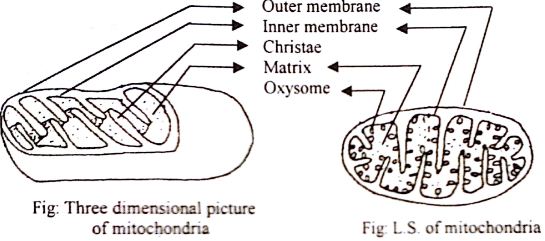The organelle present in the cytoplasm that does all the functions, such as — Kreb’s cycle, fatty acid cycle, electron transport system in order to generate the energy cell is called mitochondria.
Discovery: In 1894 Altman discovered mitochondria (sing. mitochondrion).
Shape- It is usually round, filamentous or rod-like in shape.
Number: Each in average contains 300-500 mitochondria.
Structure:
(i) It is surrounded by a two-layered membrane. The inner membrane produces projections pointed towards the centre, known as cristae.
(ii) There are a plenty of round shaped organs on the outer surface of cristae, called oxysomes.
(iii) Besides, the liquid matrix is also present in the mitochondria.

Functions:
(i) Mitochondria supply energy for all kinds of physiological activities of the cell.
(ii) There are different kinds of enzymes, co-enzymes are found in mitochondria for respiration.
(iii) All reactions. Except for glycolysis, such as- Kreb’s cycle, electron transport, oxidative phosphorylation etc take place within the mitochondria.
(iv) Mitochondria ensure the regulated flow of electron.
(v) ADP turns into ATP due to phosphorylation and is stored in the same organelle.
(vi) Mitochondria also take part in the formation of DNA and RNA.
(vii) Mitochondria also take part in the metabolic activities of lipid.











